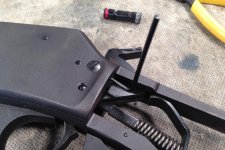I started this thread earlier: http://smith-wessonforum.com/firearms-knives-other-brands/696957-1866-vs-1873-lever-action-rifle.html#post141686417
I am most interested in one of the historical 1866 or 1873 rifles, for the historical experience, for plinking, for home defense that that thread was about.
But something I read someone wrote elsewhere, was that the safety on the new copies of the 1866/1873, is more or less accurate as they historically were, which is the point, but that also the poor safety from the 19th century comes with the purchase. I hadn't really thought about that. For example, if you happen to drop the rifle and it is loaded, the rifle can shoot by itself, since unlike similar new rifles, there is no built-in safety that prevents this.
Then also if you have to unload the tube magazine, as I understand it, you have to work with action for each shot to come out, which can be dangerous, as it is not uncommon to accidentally shoot the weapon. It does not feel so safe really, and especially not if more than me, family members, etc. are going to shoot the weapon.
I have heard many people say that modern rifles from Henry repeating arms are the most safe option, they both have built-in protection so that the rifle does not shoot if you happen to drop it, and you can both load and more importantly reload quickly, safely and easily, by emptying the tube magazine. Here: Henry Color Case Hardened 357 Mag Lever Action Review - YouTube and here: Henry 45 70 Side Gate Lever Action Rifle Review - YouTube for example.
While others believe that loading close to the muzzle as on the Henry rifles can also be dangerous and that unloading is not as effective and safe as claimed.
(Also Henrys, rifles (except the 1860 Henry rifle) are not historical, although their Henry Big Boy in brass seems quite similar to the 1866 rifle.)
So I became somewhat uncertain about how to think about safety. Anyone here who has experience and can tell me what is true about safety and what I should consider?
Thank you.
I am most interested in one of the historical 1866 or 1873 rifles, for the historical experience, for plinking, for home defense that that thread was about.
But something I read someone wrote elsewhere, was that the safety on the new copies of the 1866/1873, is more or less accurate as they historically were, which is the point, but that also the poor safety from the 19th century comes with the purchase. I hadn't really thought about that. For example, if you happen to drop the rifle and it is loaded, the rifle can shoot by itself, since unlike similar new rifles, there is no built-in safety that prevents this.
Then also if you have to unload the tube magazine, as I understand it, you have to work with action for each shot to come out, which can be dangerous, as it is not uncommon to accidentally shoot the weapon. It does not feel so safe really, and especially not if more than me, family members, etc. are going to shoot the weapon.
I have heard many people say that modern rifles from Henry repeating arms are the most safe option, they both have built-in protection so that the rifle does not shoot if you happen to drop it, and you can both load and more importantly reload quickly, safely and easily, by emptying the tube magazine. Here: Henry Color Case Hardened 357 Mag Lever Action Review - YouTube and here: Henry 45 70 Side Gate Lever Action Rifle Review - YouTube for example.
While others believe that loading close to the muzzle as on the Henry rifles can also be dangerous and that unloading is not as effective and safe as claimed.
(Also Henrys, rifles (except the 1860 Henry rifle) are not historical, although their Henry Big Boy in brass seems quite similar to the 1866 rifle.)
So I became somewhat uncertain about how to think about safety. Anyone here who has experience and can tell me what is true about safety and what I should consider?
Thank you.
Last edited:













